西方文化入门教学大纲
- 格式:doc
- 大小:92.50 KB
- 文档页数:24
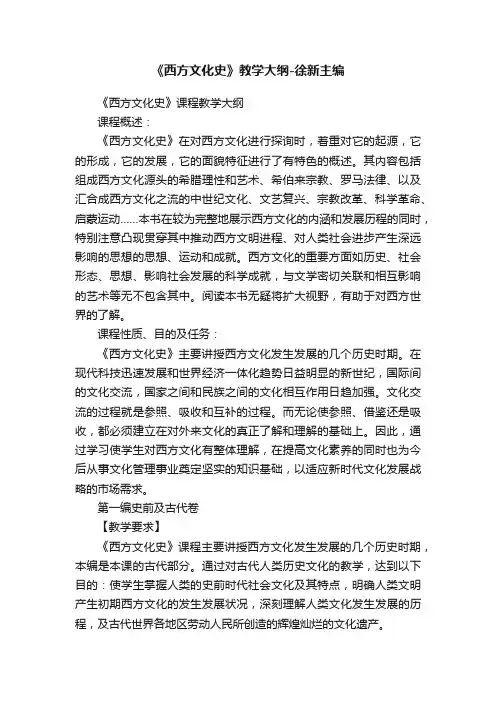
《西方文化史》教学大纲-徐新主编《西方文化史》课程教学大纲课程概述:《西方文化史》在对西方文化进行探询时,着重对它的起源,它的形成,它的发展,它的面貌特征进行了有特色的概述。
其内容包括组成西方文化源头的希腊理性和艺术、希伯来宗教、罗马法律、以及汇合成西方文化之流的中世纪文化、文艺复兴、宗教改革、科学革命、启蒙运动……本书在较为完整地展示西方文化的内涵和发展历程的同时,特别注意凸现贯穿其中推动西方文明进程、对人类社会进步产生深远影响的思想的思想、运动和成就。
西方文化的重要方面如历史、社会形态、思想、影响社会发展的科学成就,与文学密切关联和相互影响的艺术等无不包含其中。
阅读本书无疑将扩大视野,有助于对西方世界的了解。
课程性质、目的及任务:《西方文化史》主要讲授西方文化发生发展的几个历史时期。
在现代科技迅速发展和世界经济一体化趋势日益明显的新世纪,国际间的文化交流,国家之间和民族之间的文化相互作用日趋加强。
文化交流的过程就是参照、吸收和互补的过程。
而无论使参照、借鉴还是吸收,都必须建立在对外来文化的真正了解和理解的基础上。
因此,通过学习使学生对西方文化有整体理解,在提高文化素养的同时也为今后从事文化管理事业奠定坚实的知识基础,以适应新时代文化发展战略的市场需求。
第一编史前及古代卷【教学要求】《西方文化史》课程主要讲授西方文化发生发展的几个历史时期,本编是本课的古代部分。
通过对古代人类历史文化的教学,达到以下目的:使学生掌握人类的史前时代社会文化及其特点,明确人类文明产生初期西方文化的发生发展状况,深刻理解人类文化发生发展的历程,及古代世界各地区劳动人民所创造的辉煌灿烂的文化遗产。
【教学重难点】两河流域文明;古埃及文明;希伯来文明;罗马文明;基督教文明等。
【教学内容】第一章人类文明的曙光,西方文化的先声第一节两河流域文明:人类文明的摇篮第二节古埃及文明:绵延持久第三节近东文明对西方文明的影响第二章希伯来文明:信仰生活的构筑者第一节走进历史:卓尔不群第二节文明成就:化成天下第三章希腊文明:探索人类自身的文明第一节历史:由海洋孕育的文明第二节文明成就:典范之作万世师表第四章罗马文明:伟大的借鉴第一节历史:不断进取的民族第二节文明成就:在借鉴与弘扬之间第三节基督教的兴起第五章中世纪:造就欧洲社会和民族的时代第一节历史:千年的进程第二节中世纪的基督教会:统一欧洲的力量第三节文明成就:对西方文化的塑造第四节拜占庭文明第二编近代卷【教学要求】通过本章的教学,达到以下教学目的:使学生了解世界历史近代三大社会变革,深刻理解文艺复兴时代人性的光辉、启蒙时代的理性主义及其对世界文化的影响,了解巴洛克艺术特色及其世界意义,认识宗教改革的思想解放作用,深切领会在实验的时代科学革命对于人类社会文化发展的巨大推动作用。
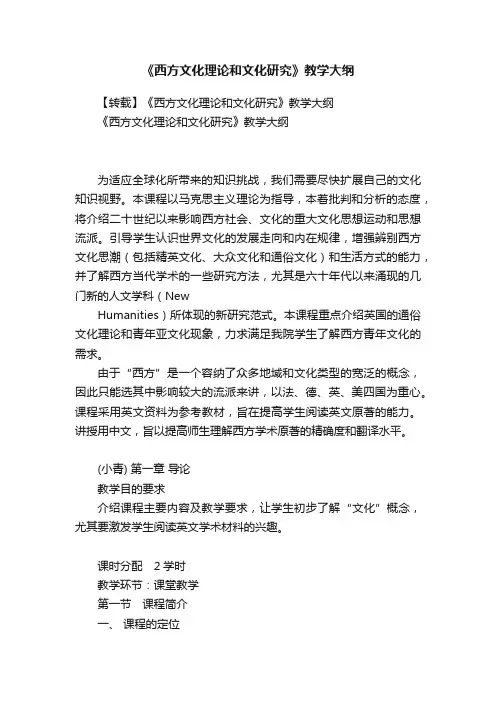
《西方文化理论和文化研究》教学大纲【转载】《西方文化理论和文化研究》教学大纲《西方文化理论和文化研究》教学大纲为适应全球化所带来的知识挑战,我们需要尽快扩展自己的文化知识视野。
本课程以马克思主义理论为指导,本着批判和分析的态度,将介绍二十世纪以来影响西方社会、文化的重大文化思想运动和思想流派。
引导学生认识世界文化的发展走向和内在规律,增强辨别西方文化思潮(包括精英文化、大众文化和通俗文化)和生活方式的能力,并了解西方当代学术的一些研究方法,尤其是六十年代以来涌现的几门新的人文学科(NewHumanities)所体现的新研究范式。
本课程重点介绍英国的通俗文化理论和青年亚文化现象,力求满足我院学生了解西方青年文化的需求。
由于“西方”是一个容纳了众多地域和文化类型的宽泛的概念,因此只能选其中影响较大的流派来讲,以法、德、英、美四国为重心。
课程采用英文资料为参考教材,旨在提高学生阅读英文原著的能力。
讲授用中文,旨以提高师生理解西方学术原著的精确度和翻译水平。
(小青) 第一章导论教学目的要求介绍课程主要内容及教学要求,让学生初步了解“文化”概念,尤其要激发学生阅读英文学术材料的兴趣。
课时分配2学时教学环节:课堂教学第一节课程简介一、课程的定位1)选修与跨学科问题(文化理论与文化研究)全球化时代了解“文化”的重要性2)传媒时代的需要对于通俗文化(大众文化)背后的政治经济学需要了解二、主要内容时间:本世纪,尤其是六十年代以来欧陆和英美有关大众文化的研究内容:各种思想流派课程具体内容大致概括为以下几个方面:一)英国学术界的文化理论二)“文化与文明”的传统三)西方马克思主义(卢卡奇、葛兰西、阿尔都塞、福柯、威廉斯、法兰克福学派的批判理论)四)结构主义(structuralism)及索绪尔、列维-斯特劳斯、罗兰·巴特五)后结构主义(post-structuralism)及拉康与福柯六)德里达(Derria)与解构主义(Deconstruction)七)后现代主义(post-modernism)及詹姆逊八)后殖民主义(post-colonialism)与东方主义(orientalism)九)女性主义(feminism)与性别政治运动十)文化研究(Cultural Studies)十一)大众文化(popular culture)与传媒(mass media)三、教学方法外文教材,自学为主,老师的讲解更多从课外加入讲授与讨论相结合四、考察方式平时小论文与期末开卷考察(翻译并评论)各占一半第二节何为“文化”一、古代中国有关“文化”的定义“文”与“象天法地”,自然神秘崇拜,天、地、人三文相关,从外在到内质“人文”:指人伦社会之规律,即社会生活中人与人之间纵横交织的关系,如君臣、夫妇、父子、兄弟、朋友等构成的社会网络。
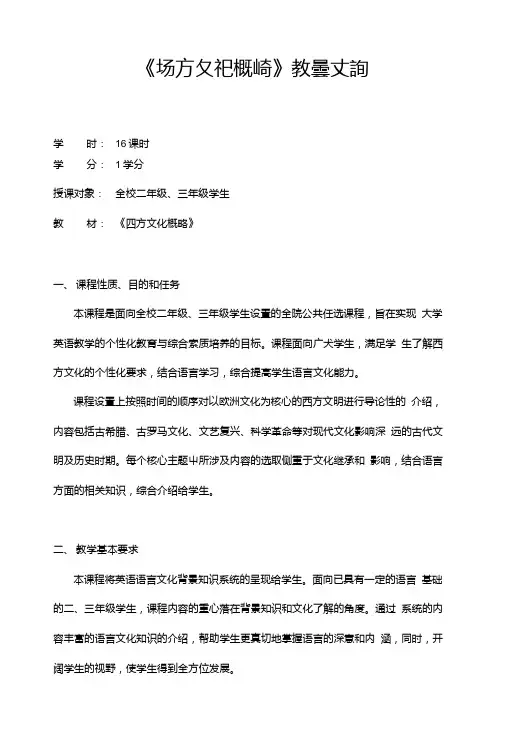
《场方夂祀概崎》教曇丈詢学时:16课时学分:1学分授课对象:全校二年级、三年级学生教材:《四方文化概略》一、课程性质、目的和任务本课程是面向全校二年级、三年级学生设置的全院公共任选课程,旨在实现大学英语教学的个性化教育与综合索质培养的目标。
课程面向广犬学生,满足学生了解西方文化的个性化要求,结合语言学习,综合提高学生语言文化能力。
课程设置上按照时间的顺序对以欧洲文化为核心的西方文明进行导论性的介绍,内容包括古希腊、古罗马文化、文艺复兴、科学革命等对现代文化影响深远的古代文明及历史时期。
每个核心主题屮所涉及内容的选取侧重于文化继承和影响,结合语言方面的相关知识,综合介绍给学生。
二、教学基本要求本课程将英语语言文化背景知识系统的呈现给学生。
面向已具有一定的语言基础的二、三年级学生,课程内容的重心落在背景知识和文化了解的角度。
通过系统的内容丰富的语言文化知识的介绍,帮助学生更真切地掌握语言的深意和内涵,同时,开阔学生的视野,使学生得到全方位发展。
三、教学基本内容周次教学内容课时第二周爱琴文明与希腊神话传说2第三周希腊时期的文化2第四周罗马时期的文化2第五周中世纪时期的基督教文化2第六周文艺复兴时期的文化2第七周宗教改革时期的文化2第八周复习总结2笫九周课程考查2四、教学重点:第一章爱琴文明与希腊神话传说克里特文化的形成、成就和影响;迈锡尼文化的特点;荷马史诗的形成与成就。
1・克里特文化:建筑、壁画和彩陶、文字、宗教。
2. 迈锡尼文化:建筑、文字。
3. 荷马时代文化:《荷马史诗》、陶艺。
第二章希腊时期的文化希腊神话的内容与特点、古希腊宗教;古风吋代的希腊文学与艺术;古典吋代的希腊悲喜剧代表作家与作品,建筑、雕刻、哲学、科学和史学的成就。
新喜剧;亚历山大里亚、小亚细亚的雕刻艺术;亚历山大里亚城的建筑;犬儒学派、伊壁鸠鲁学派、斯多喝学派、怀疑论学派;希腊化时代的宗教特点及科学成就。
1 •早期希腊的文化:神话和宗教,文字和文学,艺术。
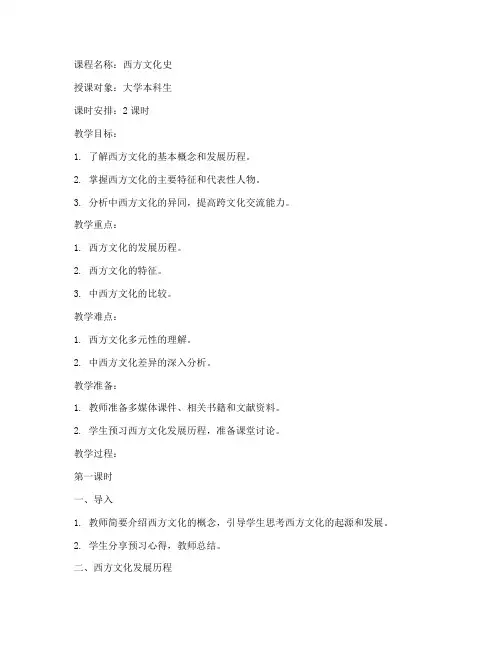
课程名称:西方文化史授课对象:大学本科生课时安排:2课时教学目标:1. 了解西方文化的基本概念和发展历程。
2. 掌握西方文化的主要特征和代表性人物。
3. 分析中西方文化的异同,提高跨文化交流能力。
教学重点:1. 西方文化的发展历程。
2. 西方文化的特征。
3. 中西方文化的比较。
教学难点:1. 西方文化多元性的理解。
2. 中西方文化差异的深入分析。
教学准备:1. 教师准备多媒体课件、相关书籍和文献资料。
2. 学生预习西方文化发展历程,准备课堂讨论。
教学过程:第一课时一、导入1. 教师简要介绍西方文化的概念,引导学生思考西方文化的起源和发展。
2. 学生分享预习心得,教师总结。
二、西方文化发展历程1. 西方文化的起源:从古希腊、古罗马时期开始,讲述西方文化的起源和发展。
2. 中世纪时期:介绍中世纪时期西方文化的主要特征,如宗教、骑士文化等。
3. 文艺复兴时期:讲述文艺复兴时期西方文化的发展,如人文主义、科学革命等。
4. 启蒙时期:介绍启蒙时期西方文化的特征,如理性主义、自由主义等。
5. 现代时期:讲述现代时期西方文化的发展,如工业革命、现代主义等。
三、西方文化特征1. 神话与哲学:介绍古希腊神话和哲学思想,如柏拉图、亚里士多德等。
2. 科学与艺术:讲述西方科学和艺术的发展,如达芬奇、牛顿等。
3. 宗教与道德:介绍西方宗教和道德观念,如基督教、基督教伦理等。
第二课时一、中西方文化比较1. 介绍中西方文化的起源、发展历程和特征。
2. 分析中西方文化在价值观、道德观念、思维方式等方面的异同。
3. 学生分组讨论,总结中西方文化差异的原因。
二、跨文化交流能力提升1. 分析跨文化交流的重要性。
2. 教授学生跨文化交流的技巧,如尊重对方文化、避免文化冲突等。
三、课堂总结1. 教师总结本节课的主要内容,强调中西方文化差异的重要性。
2. 学生分享课堂收获,教师点评。
教学反思:1. 本节课通过介绍西方文化的发展历程、特征和与东方文化的比较,使学生了解西方文化的概貌。
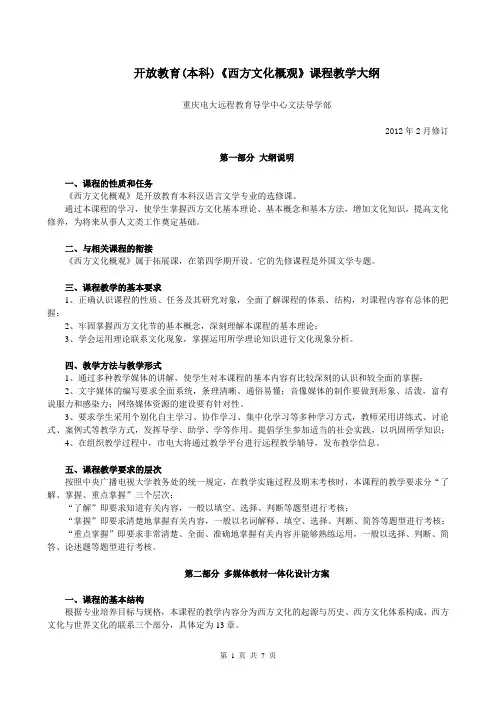
开放教育(本科)《西方文化概观》课程教学大纲重庆电大远程教育导学中心文法导学部2012年2月修订第一部分大纲说明一、课程的性质和任务《西方文化概观》是开放教育本科汉语言文学专业的选修课。
通过本课程的学习,使学生掌握西方文化基本理论、基本概念和基本方法,增加文化知识,提高文化修养,为将来从事人文类工作奠定基础。
二、与相关课程的衔接《西方文化概观》属于拓展课,在第四学期开设。
它的先修课程是外国文学专题。
三、课程教学的基本要求1、正确认识课程的性质、任务及其研究对象,全面了解课程的体系、结构,对课程内容有总体的把握;2、牢固掌握西方文化节的基本概念,深刻理解本课程的基本理论;3、学会运用理论联系文化现象,掌握运用所学理论知识进行文化现象分析。
四、教学方法与教学形式1、通过多种教学媒体的讲解,使学生对本课程的基本内容有比较深刻的认识和较全面的掌握;2、文字媒体的编写要求全面系统,条理清晰、通俗易懂;音像媒体的制作要做到形象、活泼,富有说服力和感染力;网络媒体资源的建设要有针对性。
3、要求学生采用个别化自主学习、协作学习、集中化学习等多种学习方式,教师采用讲练式、讨论式、案例式等教学方式,发挥导学、助学、学等作用。
提倡学生参加适当的社会实践,以巩固所学知识;4、在组织教学过程中,市电大将通过教学平台进行远程教学辅导,发布教学信息。
五、课程教学要求的层次按照中央广播电视大学教务处的统一规定,在教学实施过程及期末考核时,本课程的教学要求分“了解、掌握、重点掌握”三个层次:“了解”即要求知道有关内容,一般以填空、选择、判断等题型进行考核;“掌握”即要求清楚地掌握有关内容,一般以名词解释、填空、选择、判断、简答等题型进行考核;“重点掌握”即要求非常清楚、全面、准确地掌握有关内容并能够熟练运用,一般以选择、判断、简答、论述题等题型进行考核。
第二部分多媒体教材一体化设计方案一、课程的基本结构根据专业培养目标与规格,本课程的教学内容分为西方文化的起源与历史、西方文化体系构成、西方文化与世界文化的联系三个部分,具体定为13章。
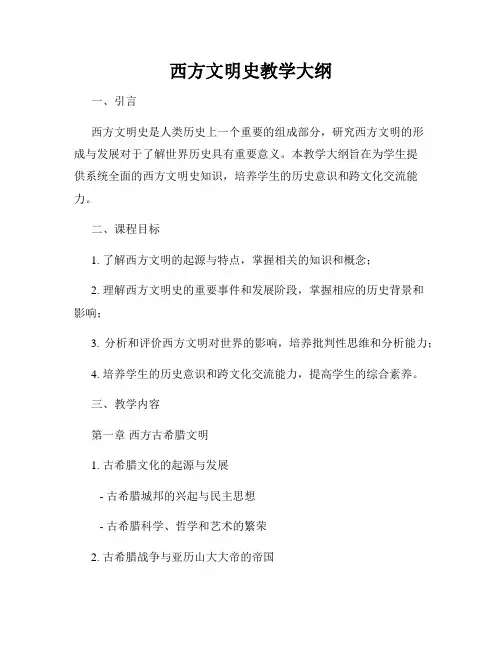
西方文明史教学大纲一、引言西方文明史是人类历史上一个重要的组成部分,研究西方文明的形成与发展对于了解世界历史具有重要意义。
本教学大纲旨在为学生提供系统全面的西方文明史知识,培养学生的历史意识和跨文化交流能力。
二、课程目标1. 了解西方文明的起源与特点,掌握相关的知识和概念;2. 理解西方文明史的重要事件和发展阶段,掌握相应的历史背景和影响;3. 分析和评价西方文明对世界的影响,培养批判性思维和分析能力;4. 培养学生的历史意识和跨文化交流能力,提高学生的综合素养。
三、教学内容第一章西方古希腊文明1. 古希腊文化的起源与发展- 古希腊城邦的兴起与民主思想- 古希腊科学、哲学和艺术的繁荣2. 古希腊战争与亚历山大大帝的帝国第二章罗马文明1. 罗马共和国时期的政治与军事- 罗马法律的起源与发展- 罗马军队的组织与扩张2. 罗马帝国的兴衰- 帝国的统治与行政制度- 基督教的兴起与罗马迫害- 西罗马帝国的灭亡与东罗马帝国的传承第三章中世纪欧洲文明1. 封建社会与教会权力- 封建制度与领主-农民关系- 教会对社会与文化的影响2. 十字军东征与欧洲文艺复兴- 十字军东征的目的与影响- 文艺复兴思潮的兴起与传播第四章文艺复兴与宗教改革1. 文艺复兴时期的艺术与科学- 杰出艺术家和文学家的作品- 科学革命的开端与变革2. 宗教改革与新教的兴起- 马丁·路德的行动与教义- 新教对欧洲的影响和分裂第五章近现代西方文明1. 经济和科技的革新- 工业革命与资本主义的兴起- 科技创新对社会的影响2. 民主与人权的进步- 法国大革命与拿破仑的时代- 西方国家的民主制度与人权思想四、教学方法和评价方式1. 教学方法- 讲授与互动:通过讲解和与学生的互动交流,使学生理解和掌握知识。
- 分组研讨:借助小组合作学习,培养学生的批判性思维和分析能力。
- 多媒体展示:利用多媒体技术呈现丰富的图像、音频和视频素材,激发学生的兴趣和好奇心。
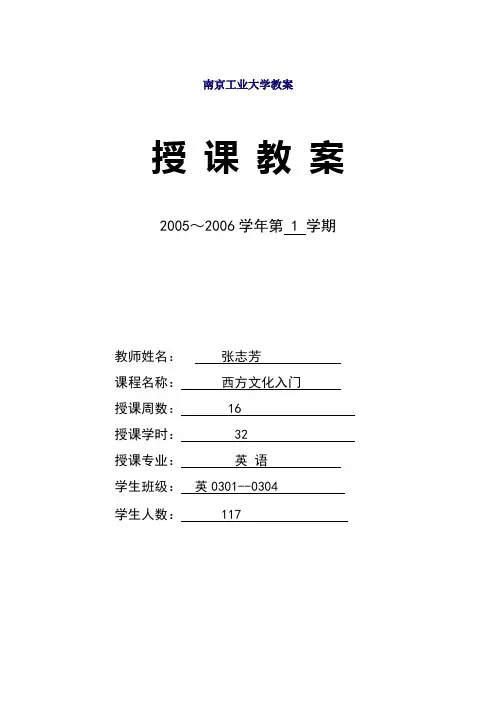
南京工业大学教案
授课教案
2005~2006学年第 1 学期
教师姓名:张志芳
课程名称:西方文化入门
授课周数: 16 授课学时: 32 授课专业:英语
学生班级:英0301--0304 学生人数: 117
外语学院英语系(教研组)
南京工业大学教案
第 1 次授课日期 05、8、29 学时数 2
授课教案
第 2 次授课日期 05、9、5 学时数 2
授课教案
第 3 次授课日期 05、9、12 学时数 2
授课教案
第 4 次授课日期 05、5 、19 学时数 2
授课教案
第 5 次授课日期 05、9、26 学时数 2
授课教案
第 6 次授课日期 05、10、3 学时数 2
授课教案
第 7 次授课日期 05、10、9 学时数 2
授课教案
第 8 次授课日期 05、10、16 学时数 2
授课教案
第 9次授课日期 05、10、23 学时数 2
授课教案
第 10 次授课日期 05、10、30 学时数 2
授课教案
第 11 次授课日期 05、11、7 学时数 2
授课教案
第 12 次授课日期 05、11、14 学时数 2
第 13 次授课日期 05、11、21 学时数 2
第 14 次授课日期 05、11、28 学时数 2
授课教案
第 15 次授课日期 05、12、5 学时数 2
授课教案
第 16 次授课日期 05、12、12 学时数 2。
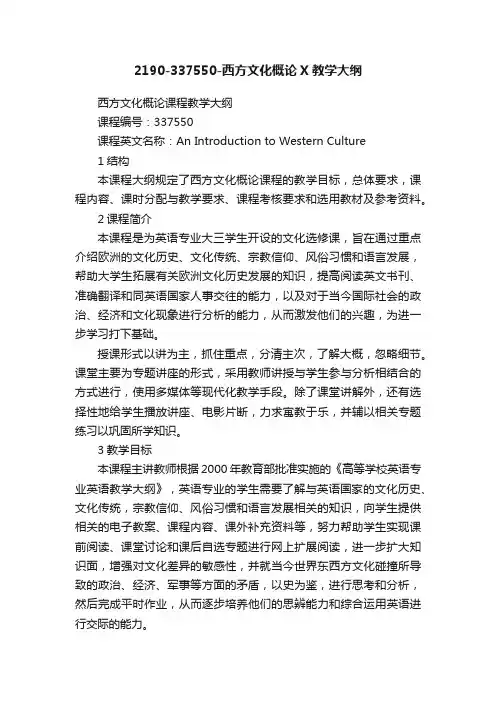
2190-337550-西方文化概论X教学大纲西方文化概论课程教学大纲课程编号:337550课程英文名称:An Introduction to Western Culture1结构本课程大纲规定了西方文化概论课程的教学目标,总体要求,课程内容、课时分配与教学要求、课程考核要求和选用教材及参考资料。
2课程简介本课程是为英语专业大三学生开设的文化选修课,旨在通过重点介绍欧洲的文化历史、文化传统、宗教信仰、风俗习惯和语言发展,帮助大学生拓展有关欧洲文化历史发展的知识,提高阅读英文书刊、准确翻译和同英语国家人事交往的能力,以及对于当今国际社会的政治、经济和文化现象进行分析的能力,从而激发他们的兴趣,为进一步学习打下基础。
授课形式以讲为主,抓住重点,分清主次,了解大概,忽略细节。
课堂主要为专题讲座的形式,采用教师讲授与学生参与分析相结合的方式进行,使用多媒体等现代化教学手段。
除了课堂讲解外,还有选择性地给学生播放讲座、电影片断,力求寓教于乐,并辅以相关专题练习以巩固所学知识。
3教学目标本课程主讲教师根据2000年教育部批准实施的《高等学校英语专业英语教学大纲》,英语专业的学生需要了解与英语国家的文化历史、文化传统,宗教信仰、风俗习惯和语言发展相关的知识,向学生提供相关的电子教案、课程内容、课外补充资料等,努力帮助学生实现课前阅读、课堂讨论和课后自选专题进行网上扩展阅读,进一步扩大知识面,增强对文化差异的敏感性,并就当今世界东西方文化碰撞所导致的政治、经济、军事等方面的矛盾,以史为鉴,进行思考和分析,然后完成平时作业,从而逐步培养他们的思辨能力和综合运用英语进行交际的能力。
4总体要求知识——古希腊和古罗马在文学、哲学、科学和艺术等不同领域取得的巨大成就,以及欧洲哲学史上的三个最伟大的哲学家;——《圣经》的主要内容和经典故事,以及基督教的起源发展和中心概念;——欧洲的封建制度,以及欧洲的文学、科学、艺术和建筑在中世纪取得的巨大成就;——宗教改革与反改革的内容,以及文艺复兴全盛时期的三个代表人物和他们的代表作品;——17世纪科学、哲学、政治和文学的代表人物,以及巴洛克艺术的代表人物和他们的代表作品;——启蒙运动的三个代表人物——孟德斯鸠、伏尔泰、卢梭和他们的学说,以及这一时期的代表人物和他们的代表作品;——浪漫主义在这一时期的代表人物和他们的代表作品,以及在不同国家取得的成就;——马克思主义的三个来源和三个组成部分、达尔文的著作和理论,以及马克思主义和达尔文学说在不同国家取得的成就;——浪漫主义和现实主义的区别,以及这一时期的代表人物和他们的代表作品;——现代主义时期的新思想和新观念,以及不同流派。
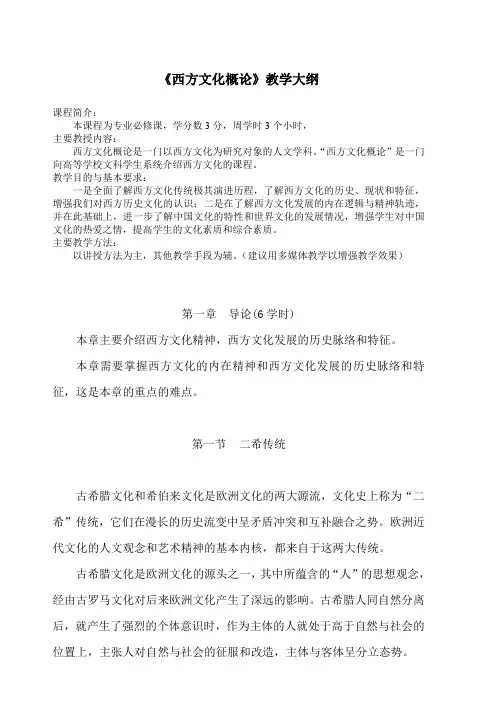
《西方文化概论》教学大纲课程简介:本课程为专业必修课,学分数3分,周学时3个小时,主要教授内容:西方文化概论是一门以西方文化为研究对象的人文学科。
“西方文化概论”是一门向高等学校文科学生系统介绍西方文化的课程。
教学目的与基本要求:一是全面了解西方文化传统极其演进历程,了解西方文化的历史、现状和特征,增强我们对西方历史文化的认识;二是在了解西方文化发展的内在逻辑与精神轨迹,并在此基础上,进一步了解中国文化的特性和世界文化的发展情况,增强学生对中国文化的热爱之情,提高学生的文化素质和综合素质。
主要教学方法:以讲授方法为主,其他教学手段为辅。
(建议用多媒体教学以增强教学效果)第一章导论(6学时)本章主要介绍西方文化精神,西方文化发展的历史脉络和特征。
本章需要掌握西方文化的内在精神和西方文化发展的历史脉络和特征,这是本章的重点的难点。
第一节二希传统古希腊文化和希伯来文化是欧洲文化的两大源流,文化史上称为“二希”传统,它们在漫长的历史流变中呈矛盾冲突和互补融合之势。
欧洲近代文化的人文观念和艺术精神的基本内核,都来自于这两大传统。
古希腊文化是欧洲文化的源头之一,其中所蕴含的“人”的思想观念,经由古罗马文化对后来欧洲文化产生了深远的影响。
古希腊人同自然分离后,就产生了强烈的个体意识时,作为主体的人就处于高于自然与社会的位置上,主张人对自然与社会的征服和改造,主体与客体呈分立态势。
希伯莱文化是欧洲文化的又一源头,其中所蕴含的“人”的观念,经由中世纪基督教文化对后来的欧洲文化产生了深远影响。
重视人的精神和理性本质,强调理性对原欲的限制,是早期希伯来文化和中世纪基督教文化价值观念的主要特征。
这种尊重理性、群体本位、崇尚自我牺牲和忍让博爱的宗教人本意识,是以后欧洲文化内核的又一层面。
基督教实际上是希腊文化和希伯莱文化两大文化传统的融合。
近代以来,为传统教义的反叛者的宗教思想家和教外思想家所重新解释的基督教日渐超出狭隘的宗教意义,渗透了西方文化的各个方面,因此,虽然近几个世纪以来宗教的外壳逐渐松动甚至解体,但宗教的内核仍深藏于西方人的价值观念、伦理原则和文化方式之中。
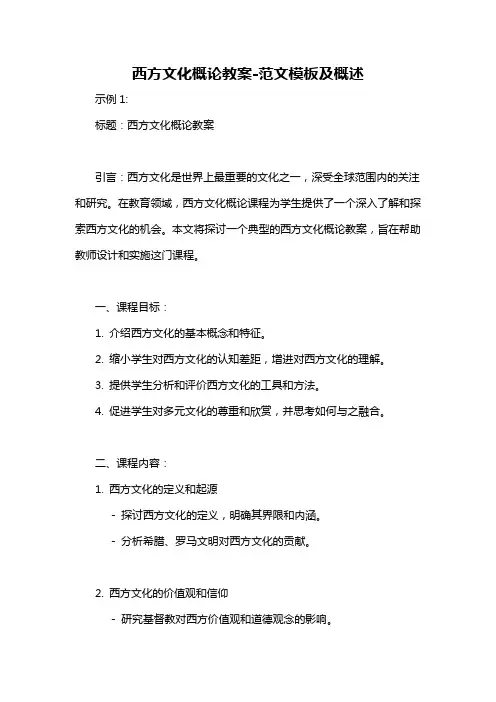
西方文化概论教案-范文模板及概述示例1:标题:西方文化概论教案引言:西方文化是世界上最重要的文化之一,深受全球范围内的关注和研究。
在教育领域,西方文化概论课程为学生提供了一个深入了解和探索西方文化的机会。
本文将探讨一个典型的西方文化概论教案,旨在帮助教师设计和实施这门课程。
一、课程目标:1. 介绍西方文化的基本概念和特征。
2. 缩小学生对西方文化的认知差距,增进对西方文化的理解。
3. 提供学生分析和评价西方文化的工具和方法。
4. 促进学生对多元文化的尊重和欣赏,并思考如何与之融合。
二、课程内容:1. 西方文化的定义和起源- 探讨西方文化的定义,明确其界限和内涵。
- 分析希腊、罗马文明对西方文化的贡献。
2. 西方文化的价值观和信仰- 研究基督教对西方价值观和道德观念的影响。
- 探讨自由、平等和个人权利的概念。
3. 西方文化的艺术与文学- 介绍古希腊罗马时期的古典艺术与文学。
- 研究文艺复兴时期的艺术和人文主义思想。
4. 西方文化的科学与哲学- 回顾古希腊的哲学思想和科学成就。
- 探讨启蒙运动时期思想家的贡献。
5. 西方文化与现代社会- 研究西方文化在当代社会中的影响力和流行文化现象。
- 探讨西方文化在全球化进程中的角色和挑战。
三、教学方法:1. 讲授- 教师通过课堂讲解和示范的方式,向学生介绍课程内容和概念。
2. 小组讨论- 将学生分为小组,让他们在课后或课堂上一起讨论相关的问题,并分享彼此的观点和观察。
3. 视频和多媒体资源- 使用视频和多媒体资源来增强学生对西方文化的了解和感知。
4. 个人研究项目- 鼓励学生选择一个关于西方文化的主题,并进行个人研究报告。
四、评估方式:1. 课堂参与度- 观察学生在课堂上的主动参与程度,包括提问、回答问题和讨论。
2. 小组讨论和合作- 评估学生在小组讨论和合作中的表现,包括发言、倾听和理解他人观点。
3. 个人研究报告- 评估学生在个人研究项目中的深度和广度。
结论:设计一门成功的西方文化概论课程需要充分考虑学生的需求和教学目标。
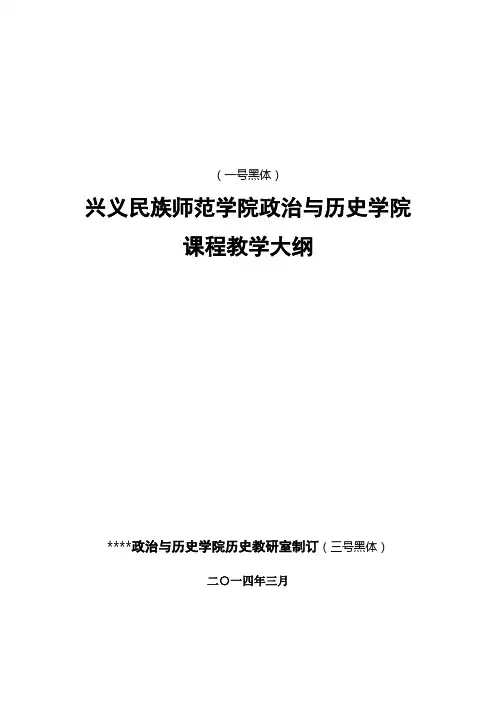
(一号黑体)兴义民族师范学院政治与历史学院课程教学大纲****政治与历史学院历史教研室制订(三号黑体)二○一四年三月《西方文化史》课程教学大纲(小二黑体)课程名称:西方文化史课程类别:专业必修课考核类别:考试适用对象:历史专业本科生适用专业:历史教育专业总学时、学分:54 学时 3 学分一、课程教学目的(三号黑体)****本课程系统地讲授了西方文化的发展历史及文化成果,目的在于使学较清晰地了解西方文明的发源,发展和文化发展的特点。
了解西方文化对世界文明进程有影响。
(小三号楷体)二、课程教学要求**将系统教授与重点难点讲授相结合,力求通过形象化的教学使学生对所学内容加深理解。
本课程介绍的文化内容十分宽泛,涉及到哲学,教育思想,文学艺术及科技成果等。
因此课程教学要求生动,深入浅出。
**三、先修课程****《世界古代史》《世界近代史》《世界现代史》《中国文化概论》四、课程教学重、难点***重点是文化发展的系统性和传承性。
难点是各种代表性文化的特征。
*五、课程教学方法(或手段)****课堂教学为主,相关教学影片播放为辅。
六、课程教学内容第一章西方文化的起源×××(××学时)(四号黑体)欧洲于公元前3000年代后半期在南欧的爱琴海地区出现了最初的奴隶制文明——爱琴文化,它成为现代西方文化的源头。
在爱琴文化基础上发展起来的希腊-罗马古典文化,是现代西方文化的“基石”。
一、欧洲史前文化人类社会的史前时期,是指有文字记载的历史之前的原始时代。
二、爱琴文化从公元前3000年代的后半期到公元前12世纪,爱琴海区域(希腊半岛、爱琴海诸岛和小亚细亚西部沿海地带)出现了欧洲最早的奴隶制文明,并创造出了辉煌的青铜文化,即爱琴文化,亦称为克里特-迈锡尼文化。
爱琴文化的发现:(德)亨利·谢里曼、(英)阿瑟·伊文斯克里特文化时间:公元前2600年至公元前1250年,约1350年。
第一章:古希腊罗马文化第一节:爱琴文明与希腊神话传说一、克里特与迈锡尼1.米诺斯(克里特)文明2.迈锡尼文明二.希腊神话传说的源流三.赫西俄德的《神谱》①四.荷马史诗与“系统叙事诗”②第二节:希腊城邦文化一.希腊城邦制度的早期发展1.城邦的发展:2.城邦及城邦与殖民地关系的特点:3.希腊城邦的政治制度变革:③二.斯巴达与雅典1.斯巴达2.雅典(1)直接民主制的实质:①①从文化学的角度来看,赫西俄德的《神谱》具有两方面的重要意义:1.它通过神系的生殖原则反映了一种朴素的宇宙起源论和自然演化观;2.它蕴涵着一种以自我否定为动力的社会进化思想。
②包括《伊利亚特》和《奥德修纪》。
③君主→僭主→民主:(2)雅典辉煌的精髓:②三.城邦时代的宗教生活与文化精神1.希腊的宗教生活2.希腊悲剧③3.希腊喜剧④四.希腊哲学的发生与演化1.起源与概况:2.唯物主义代表及米利都学派的贡献:3.唯心主义:五.希腊的科学1.早期的希腊科学很难与哲学相区别⑤①雅典的民主制是雅典公民的民主制,而公民是一个建立在家族身份和财产资格之上的荣誉称号,所以雅典的民主制只是具有浓厚的贵族色彩的民主制。
②普遍弥漫的自由精神和宽容气氛。
③悲剧三大家:埃斯库罗斯、索福克勒斯、欧利庇得斯。
命运:A.命运使希腊悲剧的基本主题,是潜藏在悲剧主人公自由行动背后的一种决定论力量。
B.希腊悲剧中的命运在稍后的希腊哲学中发展为决定现象的本质,其实质即不以人的意志为转移的自然规律或社会规律。
④代表人物:阿里斯多芬;意义:从悲剧到喜剧的转化反映了时代精神的演变,即从一种崇高典雅的整体主义和本质主义向自由散漫的个人主义和现象主义的演变,从普遍性的“命运”向个体性的自我意识的演变。
而这种时代精神的演变恰恰揭示了从希腊城邦时代向希腊化时代转化的文化实质。
⑤希腊百科全书式的伟大思想家亚里士多德在自然科学方面所产生的影响是双重性的:A.一方面,他对当时几乎所有的自然科学领域都进行了研究;B.但是另一方面,亚里士多德的一些陋见在相当长的时间里也严重阻碍近代实验科学的发展。
西方文论教学大纲第一篇:西方文论教学大纲西方文论教学大纲教学大纲一、课堂讲授内容绪论(一)西方文论的概念界定及关系处理。
(二)西方文论关于文学本质论的发展。
(三)学习西方文论的态度与方法。
第一章古希腊罗马时期的文学理论第一节概述一、古希腊历史概况二、古希腊文论发展概况三、古罗马历史及文论发展概况第二节柏拉图一、生平和著作二、文论评析第三节亚里斯多德一、生平与著作二、文艺思想第四节贺拉斯一、生平与著作二、古典主义原则三、“寓交于乐”说第五节朗吉努斯一、《论崇高》及作者二、《论崇高》的方法论三、崇高的本质四、崇高风格的构成因素第二章中世纪的文学理论第一节概述一、基督教的产生及其对文学的影响二、文学理论概况第二节奥古斯丁一、生平和著作二、文艺思想第三节文艺复兴时期的文学理论一、文艺复兴概况二、文学理论发展概况第三章 17世纪古典主义文学理论第一节概述一、古典主义产生的背景二、古典主义的基本特征三、古典主义戏剧家的理论第二节布瓦洛一、生平和著作二、文艺思想第四章 18世纪启蒙运动时期文学理论第一节概述一、启蒙运动产生的历史背景二、启蒙运动的特征及意义三、启蒙运动时期文论发展概况第二节狄德罗一、生平与著作二、关于艺术“天才”的思想三、戏剧理论第三节康德一、生平与著作二、审美判断论三、艺术创造论第五章 19世纪文学理论第一节概述一、历史概况二、文学理论发展概况第二节黑格尔一、生平和著作二、美学和文学理论的哲学基础三、美学及文艺思想第三节别林斯基一、生平和著作二、文学真实论三、文学创作论第六章 20世纪文学理论第一节概述一、现代主义产生的历史背景二、现代主义文学理论的思想和哲学基础第二节精神分析批评与原型批评一、精神分析批评二、原型批评第三节形式主义一、俄国形式主义二、英美新批评三、结构主义与解构主义第四节现象学与存在主义一、现象学二、存在主义第五节文学阐释学与接受理论一、伽达默尔与文学阐释学二、尧斯的接受美学二、训练设计方案采用课堂提问、答疑、讨论、辩论、小论文撰写等形式。
《西方文化概论》教学大纲课程编码:021*******课程名称:西方文化概论学时/学分:32 /2先修课程:适用专业:汉语言文学、汉语国际教育开课教研室:比较文学与世界文学教研室一、课程性质与任务1.课程性质:本课程是汉语言文学专业的专业课。
2.课程任务:本课程主要讲授西方文化从起源到发展所经历的三个不同的历史时期,在全球经济一体化、中西方文化交流频繁的当代,只有学习、了解、掌握西方文化,才能更好地放眼世界,开阔视野,提高学生的文化素养。
通过教学,我们要使学生了解西方文化的内涵,掌握古希腊罗马文化、中世纪基督教文化、文艺复兴时期的文化、宗教改革、启蒙主义文化等各个时期文化的发生、发展、成就、特点,包括那些在历史上推动西方文明进程的思想、运动和成果,特别是对整个人类社会进步产生巨大而深远历史影响的文化成就。
二、课程教学基本要求掌握西方文化三个重要历史时期的概况、重要社会现象。
采用课堂教师讲授与学生自学、讨论、教师点评等多种教学方式进行教学。
在规定教学范围内,教师可以引入自己的科研成果补充教学内容,鼓励学生经过阅读思考,阐述个性化的见解。
对教学内容的顺序安排、重点难点,也可根据自己的教学经验及学生的实际情况做出适当的安排和调整。
成绩考核形式:课程成绩=期终成绩(70%)+平时成绩(期中考试、作业、课堂提问等)(30%)。
成绩评定采用百分制,60分为及格。
三、课程教学内容第一章古希腊罗马文化1.教学基本要求要求学生掌握爱琴文明的基本内容、希腊城邦文化的分期和主要特点以及罗马帝国的兴衰历史。
2.要求学生掌握的基本概念、理论通过本章学习,学生能准确理解爱琴文明、城邦、公民、直接民主制、罗马帝国以及罗马法等概念或理论。
3.教学重点和难点教学重点是古代希腊城邦制度、罗马帝国的兴衰史。
教学难点是爱琴文明、古代希腊城邦政治制度。
4.教学内容第一节爱琴文明与希腊神话传说一、克里特与迈锡尼二、希腊神话传说的源流三、赫西俄德的《神谱》四、荷马史诗与“系统叙事诗”第二节希腊城邦文化一、希腊城邦制度的早期发展二、斯巴达与雅典三、城邦时代的宗教生活与文化精神四、希腊悲剧与喜剧五、希腊哲学的发生和演化六、希腊的科学第三节城邦文化的衰落与希腊化时代一、从分离主义到帝国主义二、亚历山大帝国与希腊化时代三、希腊文化的凋敝第四节罗马帝国的兴衰一、罗马的起源与发展二、罗马政治体制的演变三、罗马帝国的衰亡第五节罗马文化的特征一、罗马英雄主义的盛衰二、罗马的宗教与文化三、罗马法四、罗马世风的腐化第二章中世纪基督教文化1.教学基本要求要求学生掌握中世纪基督教文化的基本情况。
《西方文化入门》课程教学大纲 一、课程基本信息 课程代码: 课程名称:西方文化入门 课程类别:选修课 学 时:36 学 分:2 适用对象: 英语专业学生 考核方式:考试
二、课程简介 通过全面、扼要地介绍和评介西方文化的主要内容,让学生接触和了解西方社会在文明的进程中在文化、思想、社会与政治制度、艺术、文学、科学、技术等各个方面所取得主要成就,这些文化成就所取得的成因和其内涵,以及这些成就何以对人类社会的进步产生深远的影响。 同时希望通过这门课程的学习,能够进一步激发学生对西方文化的兴趣,能够自觉更广泛、更深入去学习和探索西方文化,了解和借鉴其长处,为中华文明的崛起和发扬光大尽一己之力。
三、课程性质与教学目的 1.课程性质 西方文化入门是一门集英语国家背景知识和英语语言知识为一体的英语专业限选课。
2.课程目的 本课程旨在向学生介绍所学语言国家的社会和文化等背景知识,拓宽其知识面,帮助学生了解主要英语国家的社会与文化概貌,如地理、历史、政治、经济、社会生活和文化传统等方面的基本知识,使其从文化和社会的角度更加深刻地理解和掌握所学语言知识和技能,为从事将来的工作打下较为坚实的基础。
四、教学内容及要求 第一部分:英国 第一章 英国简介 (一)目的与要求 1.掌握英国的名称,地理位置及组成部分 2.熟悉各组成部分的概况 3.了解北爱和平问题 (二)教学内容 1.主要内容:英国名称,地理,组成部分(历史,人民等),爱尔兰和平问题
2.基本概念和知识点:the UK, European Union, Commonwealth, England, Scotland, Wales, Northern Ireland, Celts, Roman invasion, Anglo-Saxons, Vikings, Norman Conquer, civil war, Restoration, Glorious Revolution, political problems in Northern Ireland, economy, population and physical features of Northern Ireland, the Home Rule Bill, the Easter Rising of 1916, the Sinn Fein Party, religious conflicts between the Irish and the British, partition of Ireland in 1921, IRA’s violence in the 1970s, Bloody Sunday, the Good Friday Agreement, etc. 3.问题与应用(能力要求):能够熟知及解释以上概念和知识点。
第二章 英国政府与政治 (一)目的与要求 1.掌握英国政府和议会的构成 2.熟悉英国君主政体 3. 掌握英国主要政党和大选 (二)教学内容 1.主要内容:英国政府,英国议会,英国君主制,英国政党,大选,英国阶级,英国民族
2.基本概念和知识点:divine right of kings, the civil war, Magna Carta, the Great Council, the Bill of Rights, the Cabinet, the Prime Minister, the Constitution, the statue law, the common laws, conventions, the power and functions of Parliament, the roles of the monarch, the House of Lords, Lords Spiritual, Lords Temporal, life peers, the House of Commons, importance of general elections, procedure of general elections, formation of the government, vote of no confidence, procedure of general elections, the Conservative Party, the Labor Party, Liberal Democrats, recent political trends in the UK, Margaret Thatcher, Tony Blair, etc.
3. 问题与应用(能力要求):能够熟知解释以上概念和知识点。
第三章 英国经济 (一)目的与要求 1.掌握主要英国经济产业 2.了解英国经济的近代发展史 (二)教学内容 1.主要内容:英国经济现状,英国经济近代史 2.基本概念和知识点:absolute decline and relative decline of British economy, the privatization in the 1980s, the main sectors of the UK economy, primary industries, secondary industries, tertiary industries, agriculture, energy production, the offshore oil industry, the manufacturing industry, the City of London, the aerospace industry.
3. 问题与应用(能力要求):能够熟知以上概念和知识点。
第四章 英国教育体系 (一)目的与要求 1.掌握英国教育体系构成 2.熟悉教育体系各阶段的具体内容 (二)教学内容 1.主要内容:英国教育体系 2.基本概念和知识点:the purpose of the British education system, the relationship between education and social class, the influence of the Church on schooling, the pursuit of equality in education, the 1944 Education Act, comprehensive schools, grammar schools, vocational schools, the National Curriculum, GCSE, GCE-A, GNVQ, prep schools, public schools, higher education, old universities, Oxford and Cambridge, the Open University
3. 问题与应用(能力要求):能够熟知以上概念和知识点。
第五章 英国外交关系 (一)目的与要求 1.掌握英国当今外交关系 2.熟悉英国外交简史 (二)教学内容 1.主要内容:英国当今外交状况,英国外交简史 2.基本概念和知识点:active in setting up the United Nations, foreign policy influenced by its history and geopolitical traits, long-term physical separation from the European continent, the involvement of the Foreign and Commonwealth Office, the Treasury, the permanent member of the UN Security Council, member of the EU, member of the Commonwealth, special relationship with the United States, the presence of superpower bases in Britain, participation in NATO
3. 问题与应用(能力要求):能够熟知以上概念和知识点。
第六章 英国住房、阶级和民族 (一)目的与要求 1. 熟悉英国住房状况 2. 熟悉英国阶级状况 3.了解英国的民族构成和概况 (二)教学内容 1.主要内容:英国当今住房状况、阶级状况和民族构成 2.基本概念和知识点:owner-occupation, flats, terraced houses, semi-deetached areas, detached houses, class system in the British society, upper middle-class and lower middle-class, the hereditary aristocracy, Oxbridge, ethnic relations in Britain.
3. 问题与应用(能力要求):能够熟知以上概念和知识点。
第七章 英国媒体、体育及节假日 (一)目的与要求 1.掌握英国主要媒体、体育及节假日名称 2.了解英国主要媒体、体育及节假日由来、内容等 (二)教学内容 1.主要内容:英国主要媒体、体育及节假日 2.基本概念和知识点:popularity and functions of the media, the quality press, the Observer, the Times, the Guardian, the Telegraph, the Financial Times, tabloids, television and radio, The British Broadcasting Corporation, The Independent Television Commission; football, “football hooligans”, FA, tennis, Wimbledon, cricket, golf, horse racing, the Grand National, the Royal Ascot,